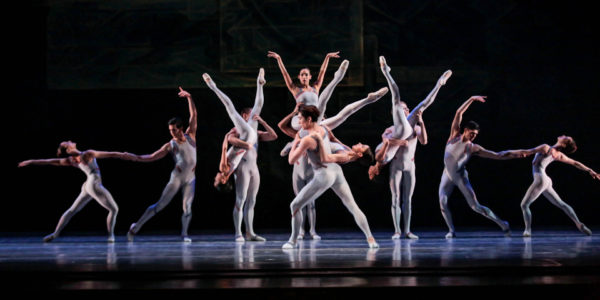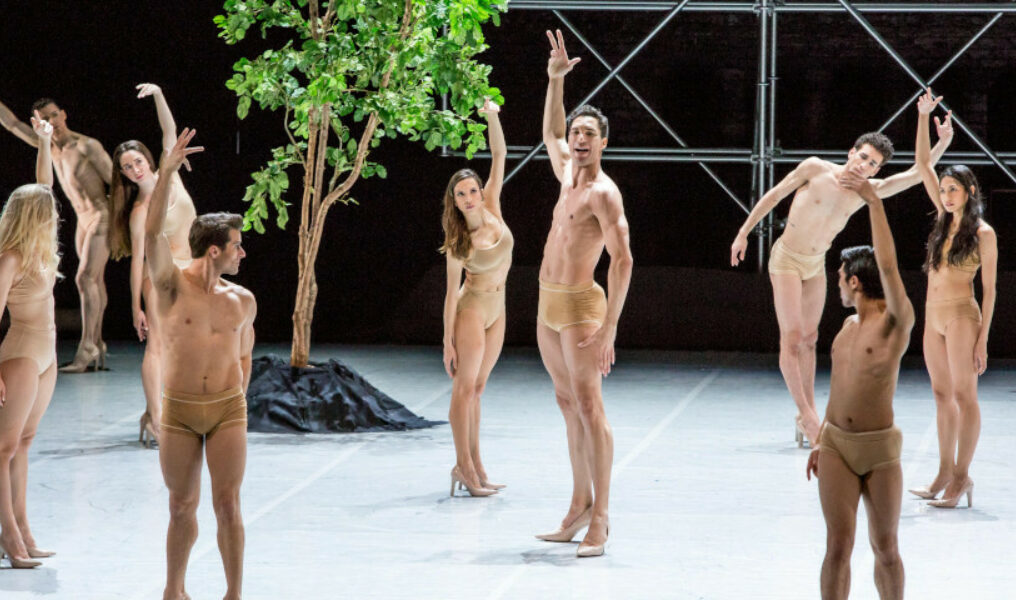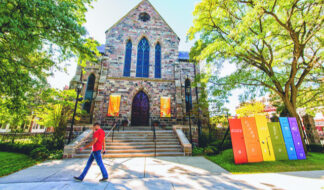The Joffrey Ballet is coming to Detroit and with it, the world-renowned ballet studio is bringing a packed weekend of three performances: "Beyond the Shore," "Vespertine" and "Joy" — but it wouldn't be a Joffrey show without something of a twist. A ballet company "committed to artistic excellence and innovation," The Joffrey says in its mission statement that it focuses on productions that are both "masterpieces of the past and cutting-edge works," and each of these upcoming performances fall into the latter category.
Playing from Saturday, Nov. 2, through Sunday, Nov. 3, each of the three pieces is choreographed by a gay choreographer and takes viewers through vastly different themes that both exemplify traditional ballet themes and push their limits. "Vespertine" by Liam Scarlett is an homage to the Baroque period. It features flowing gowns and an arguably opulent aesthetic, as well-adorned chandeliers hang above the dancers. This contrasts directly with Nicolas Blanc's "Beyond the Shore" that takes viewers between six disparate and musically inspired worlds that are based on a score by composer Mason Bates. Lastly, attendees shouldn't let the nude, stripped-down costumes in "Joy" fool them, this piece is far from bland. By Alexander Ekman, it is an exploration of happiness through movement, showing all the ranges of that emotion via dance. In advance of the show at the Michigan Opera Theatre, BTL chatted with members of The Joffrey to get a sense of what to expect in each of the three shows.
 "Joy"
"Joy"
Derrick Agnoletti has been with The Joffrey for over 15 years. Since joining, the openly gay dancer has performed in a number of works like "The Nutcracker," "Sometimes It Snows in April," "Cinderella" and "Tarantella." This time, he'll be featured in "Joy." He said of Ekman's work that it was created with a theme of fun and spontaneity in mind that translates well into the show. Especially, because it was created with direct input from its dancers.
"Alex has approaches that are often spontaneous," Agnoletti said. "For this moment and this specific piece, he was in a space where he wanted to dive into, 'What is Joy?' 'How does it make you feel?' and 'Can you find movement that brings you an authentic sensation of joy?' With Alex, I am never surprised by his approach to his work. He is also very collaborative, so he is always formulating with everyone involved."
"Joy" is unique in the realm of ballet, too, because it showcases both men and women in high heels and similar nude costumes — certainly a departure from the art form's reputation for tradition. Agnoletti said that despite the difficulty of the routine, it was well worth the effort.
"I think the concept Alex wanted in this was truly to combine our genders, but also [to] steer away from it looking like we were about to 'vogue' or 'walk a runway.' I remember him describing it as once they are put on, it's almost like we are one with the shoe without bringing any sort of fake context to it," he said. "My feet do not like walking in heels. I tend to lose my balance or rock over the outside of my ankle, so I have to be super careful and grounded when doing this specific part."
However, when asked if it was freeing to bend traditionally defined gender roles, especially as an LGBTQ-identified dancer, Agnoletti said it didn't feel that way. Instead, it was an exploration of what it meant to be happy and in unity.
"I try to not use my being a homosexual male define anything I do or allow it to. I am just an Italian-American male named Derrick who dances his heart on stage. I don't necessarily feel like I am bending any sort of gender normative. I do, however, feel like when we all have the heels on in Joy, we are all one," he said. "That unity is an interesting feeling and often one that in the ballet we don't have, given the restraints of women wearing pointe shoes and the gentlemen being in a flat shoe. To move together, walking in unison and hearing the heels all moving as we stir about the stage is quite unifying as humans."
"Beyond the Shore"
From the ambient to the otherworldly, Nicolas Blanc's "Beyond the Shore" is a six-part fantasy that is an exercise in the abstract. Each part takes the audience on a different adventure that differs in scope. Blanc's inspiration for "Beyond the Shore" came from a selection of composer Mason Bates' music, and he kept the names of each of the chosen pieces as themes for the different sections of the show.
"What's interesting about 'Beyond the Shore' is that I wanted to challenge myself," Blanc said. "… So, every five minutes, you enter into a new world that has nothing to do with the previous world. And, as a choreographer, it was a challenge, because most of the time when you create a ballet you either stick to a story. Or, if it's an abstract piece, you sort of have a theme that you carry throughout."
Though each section of "Beyond the Shore" carries with it a distinct storyline — like "Gemini in the Solar Wind," which is themed after a spacewalk, or "Broom of the System," which incorporates electronic elements into the dance — Blanc said he hopes the audience will interpret the work however they see fit.
"For instance, in the second section, the [audience] saw it already as something more alien-like, which I didn't, but I was happy that each of the audience members, according to what they hear, musically speaking, and what they see on the color palette and the lighting is the possibility to really dive into their own take on the story," Blanc said. "I think that's actually a very good thing. As a choreographer, I always want to make this point: … even if ballet is abstract, you should never let the audience feel nothing; It should never be sterile. It should always have a sense of either something that you can really dive in, something that makes you wonder what is the world, something that makes you question."
"Vespertine"
Described as "sumptuous" by the Chicago Tribune, Liam Scarlett's "Vespertine" stands out not only for its detailed costume work and Renaissance-era music but the 13 chandeliers that hang above the stage. The consistent costume changes also serve to mirror the ever-changing score. Not only that, it also features a same-sex duet.
"There is actually a male duet, it's beautifully made by Liam Scarlett," Blanc said. "And you feel this power of those two men together. … In my sense, as not the ballet master and choreographer, when I see that duet, I see the tension between the very visceral attraction between those two men. And yet, [I see] that strength, that masculine strength, between the two of them. And perhaps that's rejection and attraction."
Blanc said also that because of Scarlett's seamless interpretation of the score, LGBTQ and allied audiences alike will be able to relate to not only the show as a whole but the duet as well.
"It's not necessarily like, 'Oh, those are two men on stage.' It's so well-crafted that … there are so many meanings that you can put into this duet when you see them," Blanc said.
The Joffrey's upcoming showcase features content for everyone. To learn more about the upcoming performance and buy tickets, visit michiganopera.org. More information about The Joffrey can be found online at joffrey.org.










